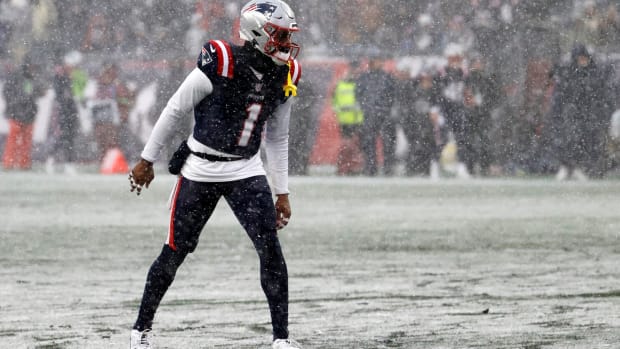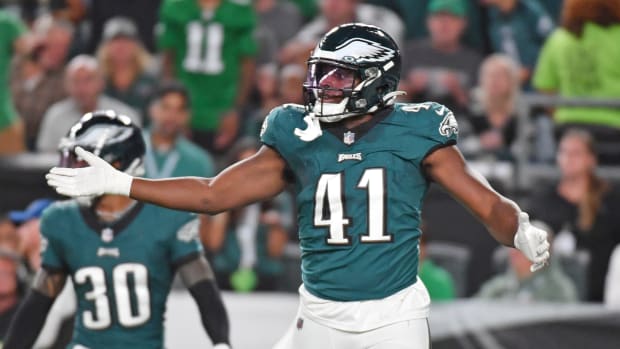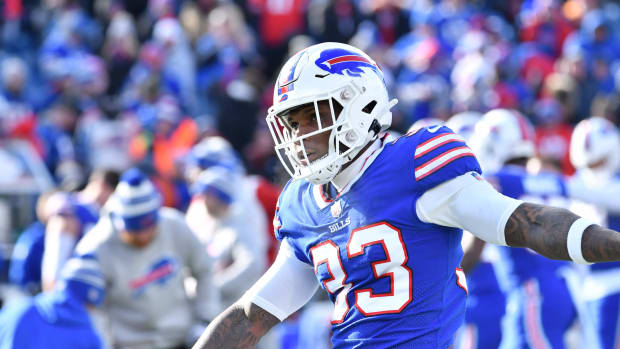
Helmetless Football? It’s the New Practice at New Hampshire
Helmets on the ground as the Wildcats go through the HUTT drill. (Jenny Vrentas/The MMQB)
DURHAM, N.H. — “TACKLE!” the head coach yells, and thus begins a five-minute period the likes of which most of us haven’t seen in American football.
Yes, the University of New Hampshire football team, the best in the FCS, is about to practice tackling. But before doing so, 25 players drop their helmets on the turf.
The next five minutes are frenzied. About a quarter of the team’s roster, wearing no helmets and no pads, take turns running toward teammates who are holding padded blocking shields. They bear-hug them, lift them off the ground for a second or two, and then sprint back into line. Head coach Sean McDonnell stands careful watch, barking commands into the chilly New Hampshire air.
Eyes through his thighs!
Run your feet on contact!
Use the leverage you’ve got!
Get that head out of it!
SURE TACKLING, SEATTLE STYLE
The MMQB’s Greg A. Bedard on how Pete Carroll and the Seahawks have embraced rugby-inspired tackling techniques to take the head out of the game, and created a video to demonstrate the style. FULL STORY
In NFL circles, New Hampshire is known as the breeding ground for Chip Kelly’s offense—the Granite State native honed his innovative strategies as the Wildcats’ offensive coordinator from 1999 to 2006. Now the school is again drawing attention, and a $500,000 research grant as a winner of the NFL’s second Head Health Challenge, with Under Armour and GE, for a different kind of innovation that could also change the game—by making it safer.
They call it HUTT, for Helmetless Tackling Training (the “u” was added to mimic the sound quarterbacks make before the snap), and it’s the brainchild of Erik Swartz, a kinesiology professor at the university. Since summer training camp, the football team has instituted at least one helmetless tackling training period per week, involving both offensive and defensive players. Two days before New Hampshire’s Nov. 22 regular-season finale against rival Maine, a game the Wildcats won to secure the No. 1 seed in the FCS playoffs, they started their afternoon practice with helmetless hitting.
The sight of players going into contact without helmets is jarring to observers accustomed to standard football drills. Players dive at tackling dummies, or push into blocking sleds, or wrap up a live runner without helmets. Their heads are bare, and so by instinct, they don’t lead with their heads.
“At first, tackling without a helmet doesn’t seem like the best idea, with the size of the guys we have around here,” says Cameron Shorey, a 6-5, 252-pound sophomore defensive end. “But when we started doing it, it made more sense to keep our heads out of the contact zone. We use our chests, use our legs, and absorb most of the force with our bodies, not our heads.”
Taking the head out of the game isn’t a novel idea, but what’s going on at New Hampshire is. Penalties and fines may discourage unsafe play, and education and technology can help mitigate the effects. But what if avoiding head contact becomes practically automatic, part of the muscle memory of a new generation of football players?
* * *
New Hampshire Sean McDonnell has embraced the experiment. (Scott W. Grau/Icon Sports Media)
Swartz spent more than a decade working at the opposite end of the spectrum, studying protective equipment like helmets and pads. Earlier this year, as a member of the NFL’s Head, Neck and Spine Committee, Swartz performed testing that led to the NFL’s ban of overbuilt facemasks. He found that the heavier masks place added strain on the neck and can compromise the helmet’s viability, while fingers can get stuck in the smaller spaces in the grill.
But while doing this research, Swartz began thinking about ways to prevent hits before they happen, and recalling his rugby-playing days. Swartz played for the Toledo Celtics Rugby Club while getting his Ph.D. in applied biomechanics from the University of Toledo, and spent another seven years playing for the Seacoast Rugby Club in New Hampshire. His position was fullback, akin to safety in football, “so if I did tackle someone,” Swartz says, “I was usually doing it with a full head of steam.”
But Swartz never led with his head in rugby, for the simple reason that his head wasn’t protected. Rugby players are taught to wrap up the ball-carrier and bring him to the ground, rather than knocking him over or using their bodies like a battering ram. Seahawks coach Pete Carroll’s instructional tackling video, which the New Hampshire coaches screened for their players this summer, also draws from rugby.
The landscape has changed during the 24 seasons McDonnell has been coaching. His current players can rattle off exactly how many concussions they’ve had, and when and how they happened.
Swartz is not suggesting that football do away with helmets, which protect the head from catastrophic injuries such as skull fractures and intracranial hemorrhages. “It’s not appropriate to take the football helmet out of the game entirely,” he says, “at least the way it’s played today.” In rugby, contact is limited to the ball-carrier and regulated by offside rules. But in a controlled football practice setting, with close supervision and carefully designed drills, players could be trained to have respect for the head by taking their helmets off.
“It’s called risk compensation,” Swartz says. “When you feel more protected, you can increase your threshold of risk. I use this example: I wouldn’t jump out of a plane without a parachute, but I might consider it if I had a parachute. You are willing to accept more risk because of a protective measure.”
Erik Swartz. (Jenny Vrentas/The MMQB)
McDonnell was on board. He and his staff had already been teaching players to keep their head out of tackles, but together McDonnell and Swartz developed a series of helmetless drills that would ingrain safer tackling techniques through motor learning. “People trust that we are going to teach their kids how to tackle properly,” McDonnell says.
The landscape has changed markedly during the 24 seasons McDonnell has been coaching at New Hampshire, 16 as the head coach. The spotlight is on player safety, and his current players can rattle off exactly how many concussions they’ve had, and when and how they happened. Mike Kelly, a junior receiver: two concussions in high school, one while playing cornerback, and the other in basketball, when he collided with a teammate and then the floor. Daniel Rowe, a junior safety: two concussions his first two seasons at New Hampshire, both while covering kickoffs.
In the past four seasons, three New Hampshire scholarship players have had to walk away from the game because of concussions. This year it was Ryan Welch, a senior defensive tackle. In 2013 it was Chris Beranger, a starting safety who had 142 tackles as a sophomore. In 2011 it was Chris Jeannot, a 6-6 tight end who’d been drawing attention from NFL scouts.
Beranger blacked out during training camp of his junior year after colliding with an offensive lineman on “any old run play.” He returned two weeks later, after passing the ImPACT testing, but he still didn’t feel like himself. During a game at Old Dominion in September 2012, he skimmed helmets with a teammate while attempting to make a tackle and saw flashing lights. The headaches he experienced for three months afterward were so severe that he had to take the semester off from school and enrolled in cognitive therapy. That was the last game he played.
“I just told myself, I could never go through that again,” says Beranger, who’ll graduate with a sociology degree this month. “It’s crazy the way it happens. Some people can take a huge hit and pop right up, and some people can take the same hit and never play again.”
* * *
The players line up around 3 p.m., about 30 minutes before practice starts, in the training room at the New Hampshire field house. Typically this is where they get taped up before practice, but this season it’s also where 50 players get an impact sensor affixed behind their right ear with a small adhesive patch. “On the really hairy people,” says one student intern, “we use Tuf-skin.”
Swartz and his research team are testing HUTT’s effectiveness. The 50 volunteers are divided into two groups: the control group, which doesn’t use the helmetless training, and a treatment group, which once a week abandons helmets for the five-minute tackling period. The sensors record every head impact a player absorbs this season, in both practices and games. “We expect the helmetless tackling training should yield fewer impacts to the head in the treatment group over time,” Swartz says. “We’re just not sure how long it’s going to take.”
This is the challenge of trying to make the game safer from the top down: retraining players who’ve been doing it another way for more than a decade. But this is also why Swartz’s research proposal was appealing to the judging panel for the Head Health Challenge, an open innovation contest that chose seven winners from among nearly 500 submissions. The other six winners were either equipment designs or new diagnostic technologies for concussions.
“Now players are getting penalized and fined [for head hits],” says Gioia. “The element that is actually unfair to the players is that they have never been taught a different way.”
“And we need that,” says Joseph Waeckerle, an independent neurologic consultant for NFL games and former Kansas City Chiefs team physician who was on the judging panel for the Head Health Challenge. “But why don’t we take a step back and try to modify behavior to lessen the risk? It made perfect sense intuitively; now we have to see, does it make sense in real life?”
Says another Head Health Challenge panelist, Gerald Gioia, a pediatric neuropsychologist at Children’s National Medical Center in Washington, “What we have not done in these contact collision sports is to explicitly train people to have respect for their head and the heads of others. Now players are getting penalized, and they are getting fined, but we have done it way too late in the game. The one element that is actually unfair to the players, is that they have never been taught a different way.”
The helmetless drills are meant to teach players to take the head out of the tackle. (Scott Ripley/University of New Hampshire)
The grant through the Head Health Challenge will allow Swartz to take the HUTT technique to a few New Hampshire high schools next season and expand his study to a younger group of players. In 2015 he'll have a chance to earn an additional $1 million grant. In the meantime he’s collecting data nearly every day with the college players.
The 50 in the study are freshmen, sophomores and juniors—since it’s a two-year study—at positions most likely to involve tackling: defensive line, linebacker, defensive back, running back, receiver and tight end. Swartz is working on an expanded protocol that would broaden its focus to other contact and would include offensive linemen.
On this Thursday afternoon, players in the treatment group complete two tackling drills without helmets and pads. In one, they start in a standing position, shuffling side to side, then speed up and enter a narrow corridor between two step-over pads, and wrap up a live runner protected by a blocking shield. The objective is to keep good form as they transition from moving laterally to entering a tight space. In the other drill the players begin face-down on the ground. When they jump up, an assistant coach cues one of two teammates, on either the left or right side, to advance toward the tackler. This emphasizes rising into contact in the correct position and maintaining it while reacting to action on the field.
• WHERE THE GAME IS HEADED: Jenny Vrentas on what a safer game might look like 10 years from now
The drills start at 3:30 p.m. Swartz stands nearby, taking attendance of the players in the study. By 3:35 the drills are over, and regular practice begins. During the entire two-hour session, the sensors affixed to the players’ heads—containing triaxial accelerometers and gyroscopes—are recording data that later will be downloaded to a laptop computer.
The daily log for each player recounts the time, intensity and location of each impact. Intensity is measured in linear acceleration and rotational velocity, and the hits are mapped on a diagram of the head, with blue arrows for lower-level hits, yellow for medium and red for high. One player’s profile shows that he sustained 45 impacts during one practice or game, eight of which were red. Only hits with a peak linear acceleration of at least 10G are recorded, and it’s not unusual to see impact forces of 100G or more—roughly equivalent to the force of a car traveling 70mph that crashes into a wall.
A readout from the sensors attached to players’ heads gives Swartz data on the number of impacts and their intensity. (Courtesy Erik Swartz/UNH)
The volume of hits collected this season is a stark reminder of the critical need to reduce head contact in football. By mid-November one subset of 20 players had totaled more than 8,000 head impacts—an average of 400 impacts per player to that point in the season. Depending on how deep its playoff run goes, New Hampshire could be practicing and playing until Jan. 10.
“If you avoid head impact, not only are you decreasing the risk of injury every time there might be an impact,” Swartz says, “but over the course of a football player’s life, if he starts at 8 or 9 years old and plays through college or the pros, think of how many impacts are sustained over that time.”
That’s something Chris Jeannot, now 25 and working as an investment analyst, is thinking about. His head trauma occurred through multiple instances of whiplash that sidelined him for eight games his junior season. He tried to return for his senior year, chasing the NFL dream he saw fellow New Hampshire tight end Scott Sicko achieve, but drowsiness, short-term memory loss and depression returned as soon as he resumed contact practices. He took the semester off, and walked away from the sport.
“I would still play football if I had to do it over again, because I felt like the game has given me much more than it has taken back,” Jeannot says. “But I don’t think I will really be able to evaluate that until I’m 40, 50, 60. If I were to have problems down the line, it might change my point of view.”
* * *
A UNH player is fitted with a sensor before practice. (Ben Knight)
Tackling without a helmet felt a little weird at first to some of the New Hampshire players. Others had to get used to the feeling of a sensor taped behind their ear. But there’s also a promising awareness among this group of college-age men about how high the stakes are for player safety.
“If I want my kids to be able to play the sport a few years down the road,” says Shorey, who is 21, “I think these are steps we need to take to up the safety of the game.”
Swartz hasn’t yet processed the data to the point at which he can draw conclusions about the effectiveness of the HUTT technique. He’s careful not to reveal too many specifics on how the drills are conducted, beyond what an observer can see at one practice, because he doesn’t want youth or high school teams implementing them incorrectly or unsafely. The New Hampshire team has adjusted the drills through the course of the season, with players working their way up to higher skill levels.
• EYES IN THE SKY: The MMQB sits with the injury spotters who are on constant watch during NFL games
He will be looking not only at the number of hits players sustain, but also at the pattern of the hits. The most dangerous, at least in terms of the risk for sustaining a neck injury, are those that occur at the front and top of the helmet. These have traditionally also been the most frequent and the highest-intensity hits. He’s also tracking the ratio of successful tackles to attempts for players in the study. Coaches hope there isn’t a drop among the group using the HUTT technique. But if the data show an increase in both tackling safety and success, that would be a selling point to other programs, at all levels of the game—including in the NFL, where a limit on the number of padded practices was imposed in the 2011 collective bargaining agreement.
As those who love football work to preserve it, the intersection of safety and success is the common goal. And in that way, the No. 1-ranked New Hampshire Wildcats are making a strong case. McDonnell points to a recent win against Delaware, one of his team’s 10 straight victories. Daniel Rowe, who volunteered for the study because, “I play safety, so I hit a lot,” made two huge plays that harked back to the helmetless training.
“We had a little reverse, and the receiver hit the outside,” Rowe says. “I kept my head to the outside, kept my body on his thigh boards, wrapped up and took him down.” The result: a four-yard loss. On another series, Delaware ran a sweep to Rowe’s side. When the player tried to cut back inside, Rowe aimed for the outside and put his shoulder on the ball, knocking it out for a forced fumble, which New Hampshire recovered.
“Guys," McDonnell told his players that day, "it’s showing up.”
Follow The MMQB on Facebook, Twitter and Instagram.
[widget widget_name="SI Newsletter Widget”]












































